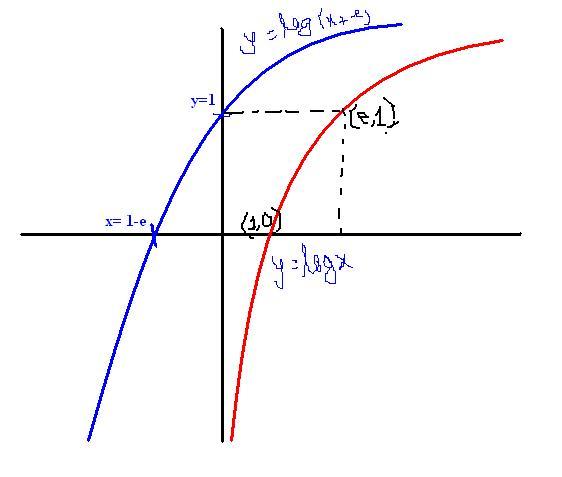have a try on it
If P (x) is a polynomial of least degree that has a maximum equal to 6 at x = 1 , and a minimum equal to 2 at
x = 3 , then01∫ P(x) dx equals
1. 17/4
2. 13/4
3. 19/4
4. 5/4
A point 'P' moves in xy plane in such a way that [| x | + | y |] = 1, where [.] denotes the greatest integer function. Area of the region representing all possible positions of the point 'P' is equal to
1. 4 sq units
2. 16 sq units
3. 2 2 sq units
4. 8 sq units
The area enclosed between the curve y = log e (x + e) and the coordinate axes is
1.] 2
2.] 1
3.] 4
4.] 3
-
UP 0 DOWN 0 0 42

42 Answers
ex does not have an area in -infinity to infinty.
but it does have an area between -infinty to zero!
yes sir integeration is a process jis mein hum choti -2 strips kaaat karuska appro area foun karte hain
iska matlab ki hum un bounded curves ka approx area nikalte hain
pls tell me if the q is right ya wrong

area required = ∫lnxdx limits are 1 to e
a simple process to eliminate Ist option is that the area reqd is greater that (e-1)*1/2 [area of triangle formed] > (2.7-1)/2 > 0.85 but it will not be much larger than 0.85 so ans. is that the area is 1.....
I think u must have mistaken my answer as option 1 area 2.... im editing that post.
at above question: manipal it al depends on how uch have u practiced, because that helps u in visualising or using any tricks. of similarly related ones u have done before.
and ya they may give but accordig to me jee questions have a speciality, u do it by 100 sentences labour or 5 sentences logic
nishant sir has answerd in post #4.. the logic is that the derivative of the function will be zero at its max. and min. valus... i.e. at x=1 and 3 and as it is mentioned that the polynomial is of least possible degree. therefore its derivative is k(x-1)(x-3)
So, the polynomial is
P(x) = kx3/3 - 2kx2 + 3kx + c
Further it is given that at x=1.... P(x)=6 and at x=3.... P(x)=
Put in P(x) and get two equations .... solve and get k and c...
k=3, c=2/3
So, P(x) = x3-2x2+9x+2/3
So, ∫Pdx = x4/4-2x3/3+9x2/2+2x/3 +m
Now evaluate the limits from 0 to 1
which is 19/4......
y do u need answr? nishant sir has answerd the steps.... it shud be up to u to solve urself...
2/3, k=3 (Refer post 4 on the last page!)
f(x) = (x3 - 6x2 + 9x + 2)
integral gives (x4/4 - 2x3 + 9/2x2 + 2x+c)
definite integral will be
1/4-2+9/2+2 = 19/4
which is option c
the derivative will be zero at both 1 and 3
so k(x-1)(x-3)=0 will be the derivative
function will be given by
k(x3/3 - 2x2 +3 x + c) si the polynomial
f(1)= 6
f(3) = 2
k(1/3 - 2 + 3 + c)=6 thus, k(4/3+c)=6
k(9 - 18 + 9 +c) = 2 thus, kc=2
thus, 4/3c+1 = 3
4/3c=2
c=2/3
also, k=3
thus we have the value of k and c and hence the polynomial!
2nd answer, area is the area of the square whose diagonal is given by 4 - square with diagonal 2.
This is 6
haan for Q2.
2>lxl+lyl≥1
This means Q lies between two squares one of side 2√2 units and other of side √2 units. so area is 8-2 = 6
manipal that is the area of the graph given by
[lxl] + [lyl] = 1
see if that is the graph needed or the one you have mentioned